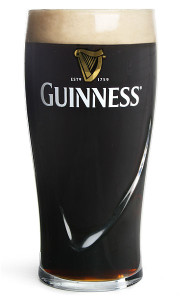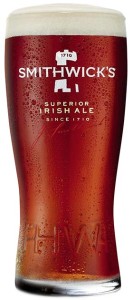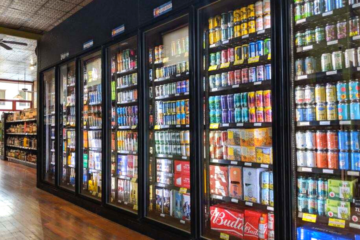Irish Beer and Culture
This month we are celebrating everything Irish! To kick things off, we present our blog on Irish Beer and Culture!
Written by Dan Carroll
 Greetings and welcome to the first official Cooper Wine & Spirits Beer Blog! My name is Dan and I’ll be your gracious author. Let me acknowledge straightaway that liquor stores and blogs don’t typically go hand-in-hand, but we at Cooper don’t work here to merely process transactions. We also have a great interest in what we sell – an interest that persists even when we’re not thinking about work.
Greetings and welcome to the first official Cooper Wine & Spirits Beer Blog! My name is Dan and I’ll be your gracious author. Let me acknowledge straightaway that liquor stores and blogs don’t typically go hand-in-hand, but we at Cooper don’t work here to merely process transactions. We also have a great interest in what we sell – an interest that persists even when we’re not thinking about work.
While some may see the products of the beer, wine, and liquor industries as manufactured, uninteresting commodities, instead we see mindful creations of brewers, vintners, and distillers, who apply their skills and knowledge to a trade they’ve spent countless hours honing, refining, and mastering. We see the result of tireless work across a huge spectrum, from farmers to sales reps. We see carried traditions with rich histories and stories to share. We see something that inspires us to learn and appreciate, and we hope it can do the same for you.
We have always done free educational tastings on Friday and Saturday evenings, but we’ve decided to expand on our efforts and launch regular blogs and podcasts for you to enjoy at your leisure. These are meant to be fun and educational for anyone, requiring no particular knowledge beforehand. They’re not meant as resources for already experts, though if that applies to you please feel free to come in the store and geek out with us. Anyway, onward to the main event.
With St. Patrick’s Day being the main event for revelers in March, it seems appropriate to center this initial blog around Irish beer and Irish beer culture. Of course St. Patrick’s Day is first and foremost a religious day of feasting, but with feasting usually comes drinking, and the Irish love drinking beer. In fact the Irish come in a #6 in beer consumed per head worldwide (the US doesn’t even break the top 10).
It mig ht not even need be mentioned, but the most popular beer in Ireland is, by far and away, the dry stout called Guinness. Also extremely popular worldwide, the ubiquitous “black stuff,” often colored green for the occasion, simply cannot be left out of any general discussion of Irish beer. Thankfully, it does merit some interest.
ht not even need be mentioned, but the most popular beer in Ireland is, by far and away, the dry stout called Guinness. Also extremely popular worldwide, the ubiquitous “black stuff,” often colored green for the occasion, simply cannot be left out of any general discussion of Irish beer. Thankfully, it does merit some interest.
Beer in Ireland, as in the countries of their UK neighbors, tends to be easy drinking and low in alcohol. It’s worth noting that drinking socially in pubs is an established tradition in those countries. Unlike bars in America that tend to serve as a place to cut loose on the weekend, traditional UK pubs offer a more casual, everyday atmosphere where people go to socialize, drink, and relax. Thus “weak” 3-5% abv beers are not scorned as such, as it’s hardly considered social drinking if you’re getting hammered.
The presence of so many examples of heavy and strong stouts around here can be accredited to the craft beer movement that is still surging in popularity. As craft brewers inherently need to create exceptional products that provide something beyond the status quo, it logically follows that craft beers tend to be stronger, heavier, and hoppier. In fairness craft brewers could try to focus on making exceptional light lagers that require a certain artisanal finesse, but as Americans we like a little less subtlety.
In contrast, the dry or Irish stout, was not thrust into consumer favor by a craft brewing revolution. It is a style that came into the existence from the slow mutation of the London Porter over centuries. The London Porter, a heavier and stronger beer than today’s Irish stout, was favored by the British working class of the 18th century. By the century’s end, the Irish had also become devoted fans of the style, and they were proficiently producing their own. By the start of the 20th century they were exporting massive quantities of their beloved porter to fans abroad.
At this point you may be wondering how a porter became lighter and also subsequently a stout. The usage of porter and stout designations have never exactly been regulated, in any sense, and in the past breweries have even produced head-buzzing “porter stouts.” Traditionally a brewery’s stout was a darker and heavier version of their porter, but there are no measurable requirements for a stout to be called such. In the case of Guinness today, their “Extra Stout” is the stronger version of their flagship brew, which is also widely available.
Anyway, over the same course of time the London Porter was proving so popular and evolving in style, Guinness had emerged as a brewing and economic powerhouse. Guinness, it seemed, was hogging most of the good fortune though, for as much success as they found, the other of brewers in Ireland found as little. The number of breweries sharply declined from hundreds to dozens, and the 1900’s only saw Guinness strengthen its grip over the nation’s beer production and consumption.
This dominance of the market actually makes Ireland unique in a couple ways. By now, and for quite some time in most cases, consumers in top beer drinking countries prefer lager for their massively produced, massively consumed beer of choice. Ireland happily acts in contrast, since Guinness, being a stout, is made with top-fermenting ale yeast. Also, most beer drinking countries are experiencing surges of interest in craft beer. Yet in Ireland craft beer hasn’t quite achieved any significant level of interest. It is currently gaining traction, but it has some catching up to do. For example, in the US craft beer holds 11-12% of the market share. That may seem somewhat high or low depending on where you are in the US, but in Ireland that number drops to an abysmal 1-2%. We have to go about 20 years back to see craft beer at that level of nationwide interest.
So for now, don’t hesitate to raise a glass of Guinness in honor of Irish beer. For more information on Irish beer, be sure to listen to Chris’s podcast, as I’m sure he’ll be apt to quickly move past the subject of Guinness.
Cheers,
Dan
